Profile
Personal Photo

|
Rating
Options
Personal Statement
Darius Wave doesn't have a personal statement currently.
Personal Info
Darius Wave
Instructor
40 years old
 Male
Male
Poland
Born April-15-1984
Interests
No Information
Statistics
Joined: 29-November 12
Profile Views: 148.240*
Last Seen: 8th January 2023 - 06:30 PM
Local Time: May 11 2024, 12:38 PM
5.871 posts (1 per day)
Contact Information
* Profile views updated each hour
 |
Darius WaveGMC Instructor
|
Topics
Posts
Gallery
Comments
Friends
My Content
8 Sep 2020
Hey there!
Gabriel has already cought me on facebook, so I decided to share it with gmc as well. Sooooooo
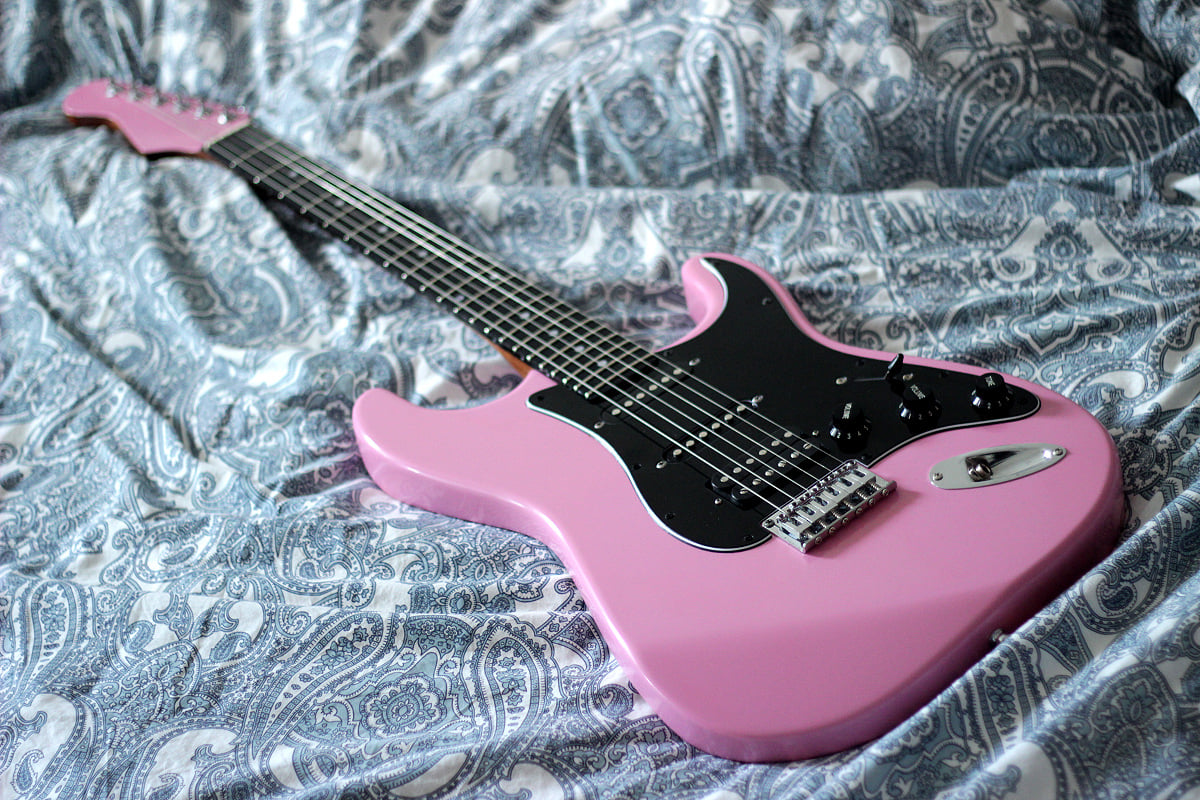
Here it is....my very first, fully self-made electric guitar.It's a strat inspired guitar with reversed headstock and fat neck. I used alder, sapele and ebony. Why? Because this particular alder piece was so bright that there was no chance to make it sound good with a maple neck (I tried with 2 different maple necks and then decided to go for Sapele)
I made a use of some spare accesorries I had in my "closet". As for electronics there are 2 Fender Prodigy ceramic Single Coils + Dimarzio DP155. Bridge and tuners are something close to sung il level. Haven't found anything improper to have reason to replace them...at least not yet.
Frets - 22 medium nickel/silver - typical fender standard fretwire - I wanted somethig easy to work with. They are not ultra hard so crowning was going nice and fast.
I accidentally made a thing that actuallyl has a name "720 mod" i guess...
The neck is lower than usually - fretboard contacts the surface of body (no space for pickguard to slide in). It has some nice affect on high frets access but it is a coincidence. I was setting up the neck pocket with a 21 fretted neck so I forgot that there should be 3 mm more left for the pickguard to hide under extended piece of fretboard.
I did some paint job with acrylic primer, synthetic color and acrylic 2K spray cans. I left enough time between coats, so different paints didn't react with each other.
All made it all in my flat, with no actual conditions to do such a things (my wife have to truly love me, she didn't tell me yet to take all this and get lost )
)
It turned out suprisingly well even with some issues in process. I guess 20 years of servicing guitars didn't went for nothing. Still wondering why did I made it so late
Why the color? Wife was jocking and i took the challenge
Why the name? Actual color is "princess violet"...little fun with letters and the name is ready - Violent Princess
That was the project I made graphically during the process:
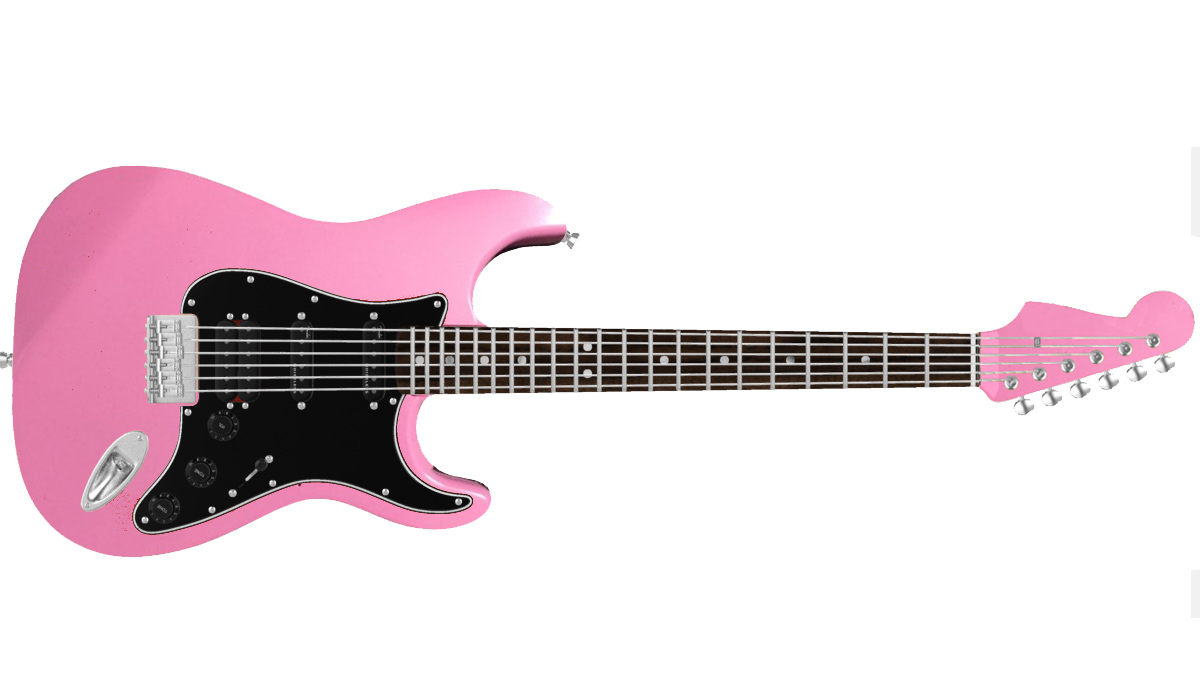
Gabriel has already cought me on facebook, so I decided to share it with gmc as well. Sooooooo

Here it is....my very first, fully self-made electric guitar.It's a strat inspired guitar with reversed headstock and fat neck. I used alder, sapele and ebony. Why? Because this particular alder piece was so bright that there was no chance to make it sound good with a maple neck (I tried with 2 different maple necks and then decided to go for Sapele)
I made a use of some spare accesorries I had in my "closet". As for electronics there are 2 Fender Prodigy ceramic Single Coils + Dimarzio DP155. Bridge and tuners are something close to sung il level. Haven't found anything improper to have reason to replace them...at least not yet.
Frets - 22 medium nickel/silver - typical fender standard fretwire - I wanted somethig easy to work with. They are not ultra hard so crowning was going nice and fast.
I accidentally made a thing that actuallyl has a name "720 mod" i guess...
The neck is lower than usually - fretboard contacts the surface of body (no space for pickguard to slide in). It has some nice affect on high frets access but it is a coincidence. I was setting up the neck pocket with a 21 fretted neck so I forgot that there should be 3 mm more left for the pickguard to hide under extended piece of fretboard.
I did some paint job with acrylic primer, synthetic color and acrylic 2K spray cans. I left enough time between coats, so different paints didn't react with each other.
All made it all in my flat, with no actual conditions to do such a things (my wife have to truly love me, she didn't tell me yet to take all this and get lost
It turned out suprisingly well even with some issues in process. I guess 20 years of servicing guitars didn't went for nothing. Still wondering why did I made it so late
Why the color? Wife was jocking and i took the challenge
Why the name? Actual color is "princess violet"...little fun with letters and the name is ready - Violent Princess
That was the project I made graphically during the process:

31 Mar 2018
Hey there! Just came by to wish you all Happy Easter time! Have a great time with your families and...take some rest from guitar....it's healthy time to time  All best!
All best!
29 Jul 2017
Let's share some of our self-customised instruments!
I have been in love with guitars for many years. Not only playing-wsie but overall construction. I'm not able to call myself a luthier but let's say I have a lot of experience in quite advanced guitar service. I can even call myself addicted to buying cheap guitars and making a lot of unreasonable work and expenses to see how much I can pull out of them. Probably most of reasonable people will simply collect the cash and buy something serious...but somehow I'm not able to
Here's one of my latest DIY advanced guitar tweaking Temporary I call it "The Crow"
Temporary I call it "The Crow" 
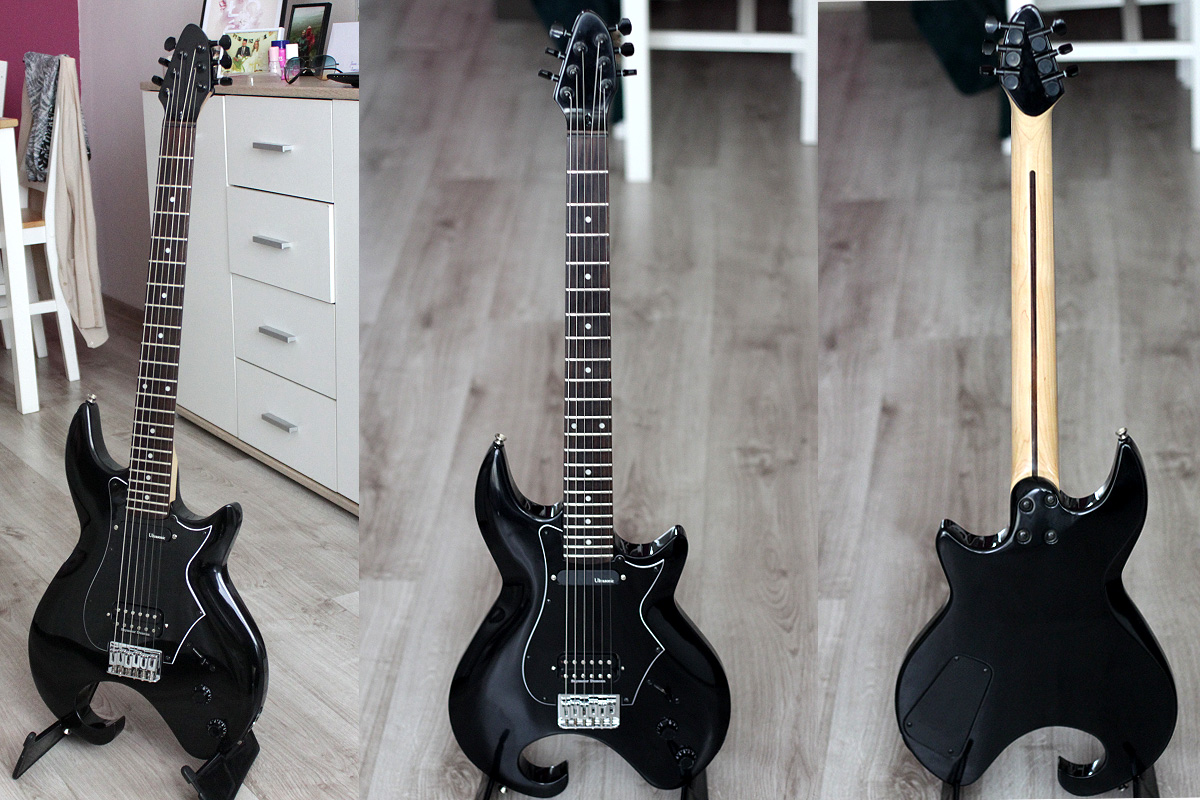
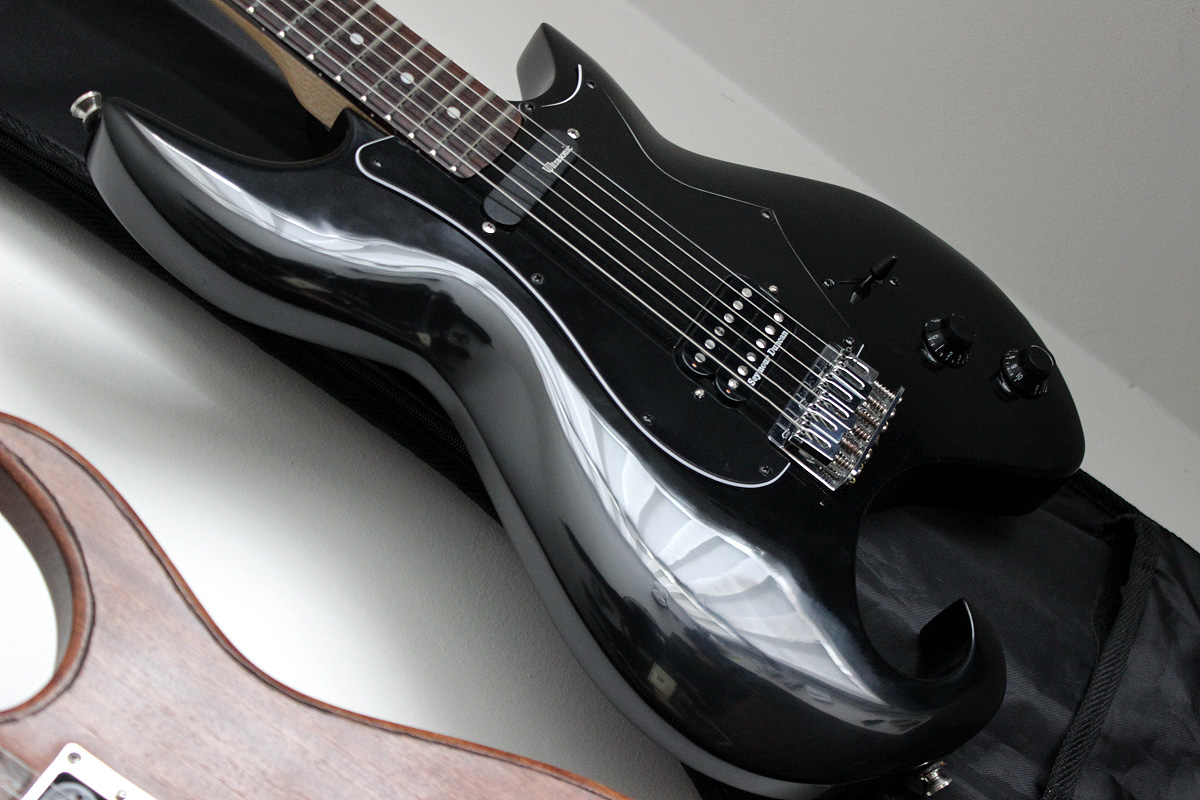
Originally it has been a Hohner Birmingham.
Around 15 years ago I had a period of reshaping the guitars but as a teenager I had not much money for tools and some other necessary stuff. I had to abandon this project for a looong time. Now I feel like I got a little "old" guitar shape-wise, and if doing ti these days, I would pass on doing any weird body cuts. But it has been done so I left it the way it was
It spent all these years in a closet and I finally decided to put it together this year.
No what the mods were:
1. Cut the headstock and made 3x3 shape instead of 6 in line
2. Painted the headstock and kept rest of the neck transparant. All has been finished with a clear coat, while originally it was just a "economic" layer of sating finish
3. Installed locking tuners
4. Replaced plastic nut with graphite one
5. Changed the neck to body angle (I wanted strings to be much closer to the body, so I've profiled the neck pocket)
6. Reshaped the body. Aside from obvious, huge cut, there are a lot of smothened, rounded profiles, that hasn't been there before
7. Replaced one-piece tune-o-matic kind of bridge with a hard-tail strat type. Wanted to have precise adjustment for each string separetly +
ability to set strings closer to the body, which was not able even if I would drill a way too deep holes for a stock bride mounting shafts.
8. Made a custom pickguard
9. Replaced stock humbuckers with SD SH-4 and STK-S4 pickups. Decided to go for a humb + single combination, which is what I actually really use these days
10. Totally reshaped electronics cavity - moved the pots away from bridge and placed a slot for 5-way switch
11. Covered old cavity for toggle switch
12. Installed a complexl copper shielding
13. Replaced electronics with a descent ones
14. Installed 5-way mega-switch that gives me these particular options:
- bridge pickup / humbucker
- bridge pickup / split
- bridge split + neck split
- neck pickup / split (dummy coil turned off for more presence)
- neck pickup /noiseless mode (for bad noise conditions at some venues)
15. Replaced tone knobs with a black. LP types
The only thing I'm missing, but it's only a matter of time, is a graphite bridge saddles. I love them since they reallygive me the comfort of not thinking about strings breackage while playing a gig. They affect the tone but within a tolerance range I accept
Tonally it came like something between strat and music man guitars. It's made of alder, maple and rosewood. The idea was to made a cheap guitar just for some live jamming etc. It turned out so well, that I actually use it quite a lot lately for all my projects.
This is how it looked before:
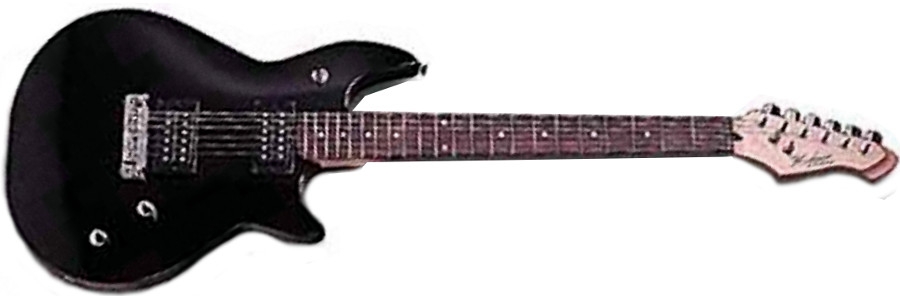
SHOW ME AND TELL SOMETHING ABOUT YOUR MODIFIED GUITARS
I have been in love with guitars for many years. Not only playing-wsie but overall construction. I'm not able to call myself a luthier but let's say I have a lot of experience in quite advanced guitar service. I can even call myself addicted to buying cheap guitars and making a lot of unreasonable work and expenses to see how much I can pull out of them. Probably most of reasonable people will simply collect the cash and buy something serious...but somehow I'm not able to
Here's one of my latest DIY advanced guitar tweaking


Originally it has been a Hohner Birmingham.
Around 15 years ago I had a period of reshaping the guitars but as a teenager I had not much money for tools and some other necessary stuff. I had to abandon this project for a looong time. Now I feel like I got a little "old" guitar shape-wise, and if doing ti these days, I would pass on doing any weird body cuts. But it has been done so I left it the way it was
It spent all these years in a closet and I finally decided to put it together this year.
No what the mods were:
1. Cut the headstock and made 3x3 shape instead of 6 in line
2. Painted the headstock and kept rest of the neck transparant. All has been finished with a clear coat, while originally it was just a "economic" layer of sating finish
3. Installed locking tuners
4. Replaced plastic nut with graphite one
5. Changed the neck to body angle (I wanted strings to be much closer to the body, so I've profiled the neck pocket)
6. Reshaped the body. Aside from obvious, huge cut, there are a lot of smothened, rounded profiles, that hasn't been there before
7. Replaced one-piece tune-o-matic kind of bridge with a hard-tail strat type. Wanted to have precise adjustment for each string separetly +
ability to set strings closer to the body, which was not able even if I would drill a way too deep holes for a stock bride mounting shafts.
8. Made a custom pickguard
9. Replaced stock humbuckers with SD SH-4 and STK-S4 pickups. Decided to go for a humb + single combination, which is what I actually really use these days
10. Totally reshaped electronics cavity - moved the pots away from bridge and placed a slot for 5-way switch
11. Covered old cavity for toggle switch
12. Installed a complexl copper shielding
13. Replaced electronics with a descent ones
14. Installed 5-way mega-switch that gives me these particular options:
- bridge pickup / humbucker
- bridge pickup / split
- bridge split + neck split
- neck pickup / split (dummy coil turned off for more presence)
- neck pickup /noiseless mode (for bad noise conditions at some venues)
15. Replaced tone knobs with a black. LP types
The only thing I'm missing, but it's only a matter of time, is a graphite bridge saddles. I love them since they reallygive me the comfort of not thinking about strings breackage while playing a gig. They affect the tone but within a tolerance range I accept
Tonally it came like something between strat and music man guitars. It's made of alder, maple and rosewood. The idea was to made a cheap guitar just for some live jamming etc. It turned out so well, that I actually use it quite a lot lately for all my projects.
This is how it looked before:

SHOW ME AND TELL SOMETHING ABOUT YOUR MODIFIED GUITARS
19 May 2017
Hey there! While answering one of student's questions I had this idea, I decided to share it with all of You.
Let's go through basic 7 modes and explain where did they came from, using a form of a little fairy tale
Long time (veeeery long time) ago there was a musican who had a broken piano. His little baby brother has taken away all the black keys and lost them in the forest. The notes that left where white keys only - c d e f g a b. Pack of those notes in this particular order sounded joyful and was known worldwide as a C-major scale. He made chords using only the notes from the list and called his song "C-major key". He was especially in love with the ones made from 1st, 4th and 5th note (C-major, F-major, G-major). He thought they are critical for that key.
Once our musician felt borred playing those happy melodies over and over again. He really wanted to make something new, but he wondered if it's really possible to do anything different with the same 7 notes.
He tried a lot but it was still sounding the same until....he occasionally made a mistake. He played notes from C-major scale but startting for a d note = d e f g a b c. He thought it's sounds different and fresh, but when he tried to play it over his beloved C, F and G chords, he realized it still sounds like C-major.
He struggled for a moment - "Why does this new notes order sound different standalone, and doesn't with the left hand backing chords?". He thought that maybe if he starts the scale form the d note, he should also make the most important chord in the key, start from d note as well. When he matched the notes, he found it would be D-minor chord.
He already knew that chords made from 1st, 4th and 5th note from the scale, are the coolest ones, so he made missing two chords for a new key, having a complete list of D-minor, G-major, A-minor. Now everything was sounding "the new way".
He then thought "how cool is that". Maybe I should do the same with every note from C-major scale.
So he did. This way he created a pack of modes and gave them names:
D-dorian (made from 2nd note of C-major) = d e f g a b c d (important chords - D-minor, G-major, A-minor) . He didn't knew that someday this scale will become so important for all funky, blues and rock playing
E-phrygian (made from 3rd note of C-major) = e f g a b c d e (important chords - E-minor, A-minor, B-half-diminished). He had no idea that someday this would be used a lot in metal music to create sort of oriental flavor.
F-lydian (made from 4th note of C-major) = f g a b c d e f (important chords - F-major, B half-dimished, C-major). If he could knew this would be one of most favorite scales for Steve Vai
G-mixolydian (made from the 5th note of C-major) - g a b c d e f g (important chords - G-major, C-major, D-minor). How great it would be to know this scale would be a basis of most of major blues and rock'n'roll
A-aeolian minor (made from 6th note of C-major) - a b c d e f g a (important chords - A-minor, D-minor, E-minor). It sounded so sad and opposite to major scale, that he decided it would be most commonly used scale, right next to major.
B-locrian mode (made on 7th note of C-major) - b c d e f g a b (important chords - B half-diminished, E-minor, F-major). It sounded so weird that he thought there's not much use for it unless somone will discover jazz someday.
When he was done he was surprised how much it was possible to be done with those 7 notes he had at the beginning. He realized it's not the notes themselves but the interaction between notes and backing chords + the intervals between each step from the scale.
He had a huge hope to find missing black keys someday and wondered it would be nice to also name specific points of each of these modes, so everyone could make one from any note of his choice.
He figured out that:
Major scale is a one that has a half-step between 3rd - 4th and 7th-8th notes, while all other notes have a wholestep between them
Dorian mode is just a minor scale with 6th note being pushed one halfstep up
Phrygian mode is just a minor scale but it's 2nd note had not enough strength to climb to proper fret, so there's a half-step between 1st and 2nd step + half-step between 5th and 6th step
Lydian mode is just a major scale but it's 4th note has been moved half-step up
Mixolydian mode is....just a major scale but it's 7th note has fallen 1 half-step down
Minor mode is a scale where between 2nd-3rd and 5th-6th notes there area helf-steps. Between all other notes there are whole-steps
Locrian mode has half-steps beteeen 1st-2nd note and 4th-5th note. Between other notes there's always a whole-step
After few years he found his black keys in the forest and he was experimenting with all the modes he made. He suddenly realized it's quite hard to learn all the notes for each of those modes all over the keyboard.
He than had the idea it would be much simpler to memorize relations between scales - just 7,and use them to translate something wierd sounding to something more friendly.
He learned all the relations so he could quickly use that skill in his playing.
First occasion was when his friend asked him to play over A-mixolydian track (performed by his friend's folk band). He sudddenly thought that his mind feels empty while thinking of that name and looking at the keyboard. So he made some calculation. A-mixolydian was mad on a 5th step of some major scale. So A note = 5th note. Counting down a 5th interval from A note, he found it was D note. So D was the root major key, that A-mixolydian has been made. In other words A-mixyolydian has exactly the same note names as D-major scale. When he hear "D-major" name, he suddenly felt like all the keyboard looks so familiar for that key. This way he saw D-major notes on the keybaord, but playing over A-mixolydian track. Everything was clear.
Trying to explain this method to his firends, he found out that each of them feels better with different of those modes. Some felt "unlocked" for improvisation, while they translated the "weird name" into a relative minor scale.
One of his friends was amazed when he heard that playing over G# locrian mode is as simple as using notes and shapes he new for F#-minor scale.
Another was was happy to use his favorite A-minor scale, shapes and licks to play over F-lydian track.
And they all lived happy every after because they knew the pattern instead of learning tons of keys separetly
And....that's the punchline
ALWAYS MAKE THINGS SIMPLE, FIND RELATIONS, LEARN PATTERNS, TRANSLATE TO THINGS YOU ARE FAMILIAR WITH.
This way you save some time and learn how do things work in music, not just that they are.
Let's go through basic 7 modes and explain where did they came from, using a form of a little fairy tale
Long time (veeeery long time) ago there was a musican who had a broken piano. His little baby brother has taken away all the black keys and lost them in the forest. The notes that left where white keys only - c d e f g a b. Pack of those notes in this particular order sounded joyful and was known worldwide as a C-major scale. He made chords using only the notes from the list and called his song "C-major key". He was especially in love with the ones made from 1st, 4th and 5th note (C-major, F-major, G-major). He thought they are critical for that key.
Once our musician felt borred playing those happy melodies over and over again. He really wanted to make something new, but he wondered if it's really possible to do anything different with the same 7 notes.
He tried a lot but it was still sounding the same until....he occasionally made a mistake. He played notes from C-major scale but startting for a d note = d e f g a b c. He thought it's sounds different and fresh, but when he tried to play it over his beloved C, F and G chords, he realized it still sounds like C-major.
He struggled for a moment - "Why does this new notes order sound different standalone, and doesn't with the left hand backing chords?". He thought that maybe if he starts the scale form the d note, he should also make the most important chord in the key, start from d note as well. When he matched the notes, he found it would be D-minor chord.
He already knew that chords made from 1st, 4th and 5th note from the scale, are the coolest ones, so he made missing two chords for a new key, having a complete list of D-minor, G-major, A-minor. Now everything was sounding "the new way".
He then thought "how cool is that". Maybe I should do the same with every note from C-major scale.
So he did. This way he created a pack of modes and gave them names:
D-dorian (made from 2nd note of C-major) = d e f g a b c d (important chords - D-minor, G-major, A-minor) . He didn't knew that someday this scale will become so important for all funky, blues and rock playing
E-phrygian (made from 3rd note of C-major) = e f g a b c d e (important chords - E-minor, A-minor, B-half-diminished). He had no idea that someday this would be used a lot in metal music to create sort of oriental flavor.
F-lydian (made from 4th note of C-major) = f g a b c d e f (important chords - F-major, B half-dimished, C-major). If he could knew this would be one of most favorite scales for Steve Vai
G-mixolydian (made from the 5th note of C-major) - g a b c d e f g (important chords - G-major, C-major, D-minor). How great it would be to know this scale would be a basis of most of major blues and rock'n'roll
A-aeolian minor (made from 6th note of C-major) - a b c d e f g a (important chords - A-minor, D-minor, E-minor). It sounded so sad and opposite to major scale, that he decided it would be most commonly used scale, right next to major.
B-locrian mode (made on 7th note of C-major) - b c d e f g a b (important chords - B half-diminished, E-minor, F-major). It sounded so weird that he thought there's not much use for it unless somone will discover jazz someday.
When he was done he was surprised how much it was possible to be done with those 7 notes he had at the beginning. He realized it's not the notes themselves but the interaction between notes and backing chords + the intervals between each step from the scale.
He had a huge hope to find missing black keys someday and wondered it would be nice to also name specific points of each of these modes, so everyone could make one from any note of his choice.
He figured out that:
Major scale is a one that has a half-step between 3rd - 4th and 7th-8th notes, while all other notes have a wholestep between them
Dorian mode is just a minor scale with 6th note being pushed one halfstep up
Phrygian mode is just a minor scale but it's 2nd note had not enough strength to climb to proper fret, so there's a half-step between 1st and 2nd step + half-step between 5th and 6th step
Lydian mode is just a major scale but it's 4th note has been moved half-step up
Mixolydian mode is....just a major scale but it's 7th note has fallen 1 half-step down
Minor mode is a scale where between 2nd-3rd and 5th-6th notes there area helf-steps. Between all other notes there are whole-steps
Locrian mode has half-steps beteeen 1st-2nd note and 4th-5th note. Between other notes there's always a whole-step
After few years he found his black keys in the forest and he was experimenting with all the modes he made. He suddenly realized it's quite hard to learn all the notes for each of those modes all over the keyboard.
He than had the idea it would be much simpler to memorize relations between scales - just 7,and use them to translate something wierd sounding to something more friendly.
He learned all the relations so he could quickly use that skill in his playing.
First occasion was when his friend asked him to play over A-mixolydian track (performed by his friend's folk band). He sudddenly thought that his mind feels empty while thinking of that name and looking at the keyboard. So he made some calculation. A-mixolydian was mad on a 5th step of some major scale. So A note = 5th note. Counting down a 5th interval from A note, he found it was D note. So D was the root major key, that A-mixolydian has been made. In other words A-mixyolydian has exactly the same note names as D-major scale. When he hear "D-major" name, he suddenly felt like all the keyboard looks so familiar for that key. This way he saw D-major notes on the keybaord, but playing over A-mixolydian track. Everything was clear.
Trying to explain this method to his firends, he found out that each of them feels better with different of those modes. Some felt "unlocked" for improvisation, while they translated the "weird name" into a relative minor scale.
One of his friends was amazed when he heard that playing over G# locrian mode is as simple as using notes and shapes he new for F#-minor scale.
Another was was happy to use his favorite A-minor scale, shapes and licks to play over F-lydian track.
And they all lived happy every after because they knew the pattern instead of learning tons of keys separetly
And....that's the punchline
ALWAYS MAKE THINGS SIMPLE, FIND RELATIONS, LEARN PATTERNS, TRANSLATE TO THINGS YOU ARE FAMILIAR WITH.
This way you save some time and learn how do things work in music, not just that they are.
3 Apr 2017
Hey there!
As we all know some of our gear is more or less sensitive for any noise comming from power supply. For example buzzing while stage lights are on. I don't mean any kind of groud loops or noisy suppliers themselfs. Let's consider the problem being "unhealthy" AC on stage or in the rehearsal room. Let's consider everything in the rig is perfectly wired and electrically proper.
I know Furman does make power conditioners but aside from the price for a mobile, "self-employeed" musician the size makes the difference.
My request is...
DO YOU KNOW ANY CHEAP AND LITTLE power filters/conditioners?
I know that one U.S company makes a thing called HUM X and it totally solves the problem, but....I need 230V and they only make 110V for U.S market.
Maybe some of you know any alternatives that same, as hum x, are sized not much bigger than a phone power charger?
As we all know some of our gear is more or less sensitive for any noise comming from power supply. For example buzzing while stage lights are on. I don't mean any kind of groud loops or noisy suppliers themselfs. Let's consider the problem being "unhealthy" AC on stage or in the rehearsal room. Let's consider everything in the rig is perfectly wired and electrically proper.
I know Furman does make power conditioners but aside from the price for a mobile, "self-employeed" musician the size makes the difference.
My request is...
DO YOU KNOW ANY CHEAP AND LITTLE power filters/conditioners?
I know that one U.S company makes a thing called HUM X and it totally solves the problem, but....I need 230V and they only make 110V for U.S market.
Maybe some of you know any alternatives that same, as hum x, are sized not much bigger than a phone power charger?
Last Visitors
Comments
 Headbanger
Headbanger
Hey Darius, I just saw your video Guitar Jam with Andriano onYoutube...Both of you played great music...
26 Mar 2013 - 12:42
Friends
There are no friends to display.

|
Lo-Fi Version | Time is now: 11th May 2024 - 01:38 PM |






 14 Apr 2024 - 20:39
14 Apr 2024 - 20:39

